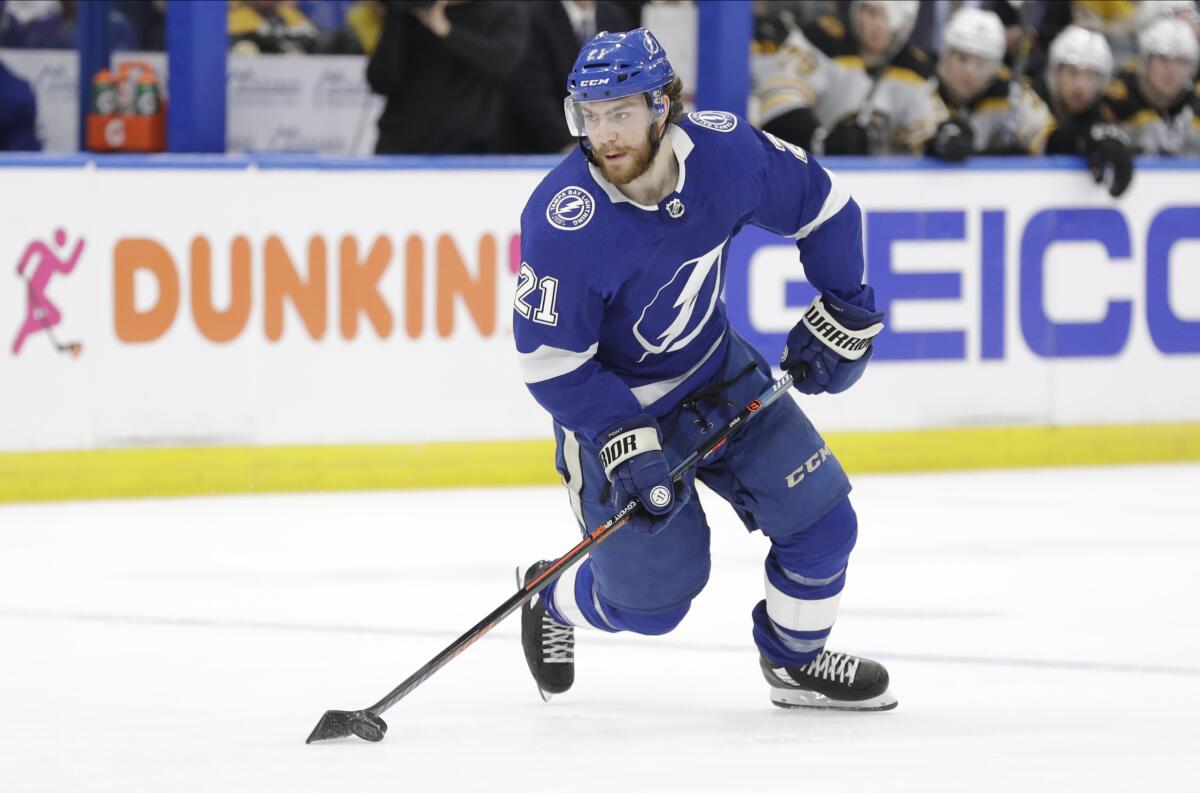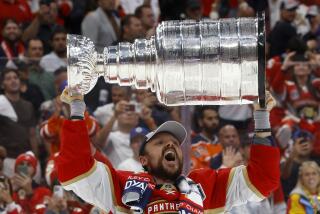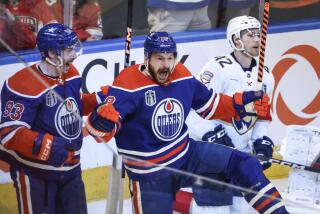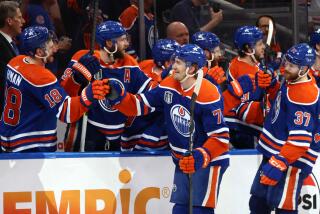NHL playoffs: Tampa Bay Lightning beat Dallas Stars to win Stanley Cup

- Share via
EDMONTON, Canada — The joyful yells from the bench could be heard in the empty arena in the final seconds and the roar from players when Commissioner Gary Bettman called for Steven Stamkos to accept the Stanley Cup echoed even louder.
The triumph of winning the NHL championship in a bubble was certainly no less sweet for the Tampa Bay Lightning.
Brayden Point scored his playoff-best 14th goal and the Lightning beat the Dallas Stars 2-0 in Game 6 on Monday night to win finish off the most unusual NHL postseason in history, staged nearly entirely in quarantine because of the pandemic.
The clock hitting zeros with no fans in attendance set off a celebration for a team that endured years of playoff heartbreak and two months in isolation — and their fans outside Amalie Arena in Tampa celebrated right along with them.
“It takes a lot to be in a bubble for 80 days or whatever long it was,” said defenseman Victor Hedman, who won the Conn Smythe Trophy as playoff MVP. “But it’s all worth it now, we’re coming home with the Cup.”
Before giving that trophy to Hedman, Bettman gave all the players credit for enduring a quarantine largely on their own for so long.
“To be in this place at this time under these circumstances is remarkable and frankly overwhelming,” Bettman said. “Frankly, all of the players who participated should feel like MVPs.”
Goals from Point and Blake Coleman and a 22-save shutout by Andrei Vasilevskiy in Game 6 were enough to power the Lightning to their second championship after winning it in 2004. That one came just ahead of a lockout that wiped out an entire season and similar uncertainty hangs in the air now because of the coronavirus.
Questions about the future were put off for a celebration by the Lightning and by the NHL, the first of the four major North American professional sports leagues to crown a champion since the start of the pandemic.
Tampa Bay’s core group closed out the final with an almost poetic display of what got the Lightning to this point over the past several years and months. Point’s goal came with assists from longtime standouts Nikita Kucherov and Hedman, key addition Coleman scored on an odd-man rush in the second and Vasilevskiy did his job on a relatively slow night in net.
Veteran defenseman Braydon Coburn was the first to get the Cup after Stamkos and Hedman, even though he played just three games in the postseason. He played 964 regular-season and 137 playoff games to get to this point, losing in the final twice before.
“The beauty of our team is everyone was chipping in,” Point said. “We got contributions from anyone and everyone at different times, and that’s what makes this win so special.”
It was more of a coronation than a challenge as the dominant Lightning outshot the Stars 29-22 and looked like the powerhouse they’ve been for much of the past decade.
In the final alone, Tampa Bay’s power play was clicking and turned the series around. Point’s goal made it 7 for 16 over the past five games to decimate the Stars, who were undone by their lack of discipline and couldn’t get enough “Dobby” magic from goaltender Anton Khudobin.
“There is no feelings right now,” Khudobin said. “Just empty, you know. We battled hard, especially with this situation, it’s not easy to stay without families for two months and stuff like that.”
The Stars simply ran out of gas after injuries piled up.
“I couldn’t ask more from our players,” said coach Rick Bowness, an assistant for Tampa Bay for five years who was part of their 2015 run that fell short in the final. “So it wasn’t enough to beat that team, so it wasn’t enough. But it’s better than sitting here saying how we could done this or could have done. We don’t second-guess anything we’ve done.”
The Lightning did to the Stars what Chicago did to them in the ‘15 final, when injuries built up. Tampa Bay had Point and No. 2 center Anthony Cirelli playing hurt this time, didn’t have Stamkos for almost all of the playoffs — and still survived.
“These last six weeks have been really emotional for my family and I, not only on the ice but off the ice,” said Stamkos, who played just 2:37 in the playoffs yet scored a goal in Game 3. “I just want to say to my family: I love you guys so much. To all the friends and everyone who supported us along the way: We love you, we can’t wait to celebrate with you.”
The painful playoff losses look like mile markers now — losing four consecutive games to Chicago after going up 2-1, blowing 3-2 series leads in the Eastern Conference final in 2016 and 2018, and last season’s jaw-dropping, first-round sweep by Columbus after the Lightning had tied the NHL single-season wins record and won the Presidents’ Trophy.
Coach Jon Cooper thought the attitude needed to change from wanting to beat every opponent 9-0 because that’s not realistic in playoff hockey. His team went 12-3 in one-goal games this postseason, and he said the Lightning won because they were strengthened by years of “heartbreak.”
Bettman was on hand exactly 200 days after his dismal if hopeful announcement that the season was being put on pause with 189 games left unplayed.
The league and players’ union worked for nearly four months to iron out where, how and when to play so 2020 wouldn’t join 1919 and 2004 as a year in which the Cup wasn’t awarded. The plan they came up with was unusual. Like the NBA, it called for walling off teams from the public for months on end. Unlike the NBA, it called for doing it in two spots — Toronto and Edmonton, while the U.S. grappled with spiking coronavirus cases in too many places for NHL leadership to feel comfortable.
And it worked. After more than 31,000 tests, there were zero positive coronavirus cases reported among players, coaches and staff inside the bubbles and just a handful among hotel, arena or restaurant employees. There was nothing close to a breakout.
Bizarre as it was with no fans and manufactured crowd noise and light shows, the hockey was often top notch. The expanded, 24-team playoffs meant there was hockey nearly every day, sometimes from midday until past midnight, including a five-overtime marathon that was the second longest in modern hockey history. And in this unprecedented postseason, there were even two elimination games on the same day in the same arena.
By the conference finals, Rogers Place, a nearby JW Marriott and the rest of a heavily fenced bubble in downtown Edmonton became the center of hockey for fans thousands of miles away with Dallas and Tampa Bay, two of the southernmost teams in the league, settling the Cup in the NHL’s northernmost arena.
In all, the NHL played 130 games in a bubble, 25 of them going into overtime, before the final horn set off a celebration by Tampa Bay that simply had to do with no fans in the stands, and few loved ones allowed on the ice to share the moment.
More to Read
Go beyond the scoreboard
Get the latest on L.A.'s teams in the daily Sports Report newsletter.
You may occasionally receive promotional content from the Los Angeles Times.






